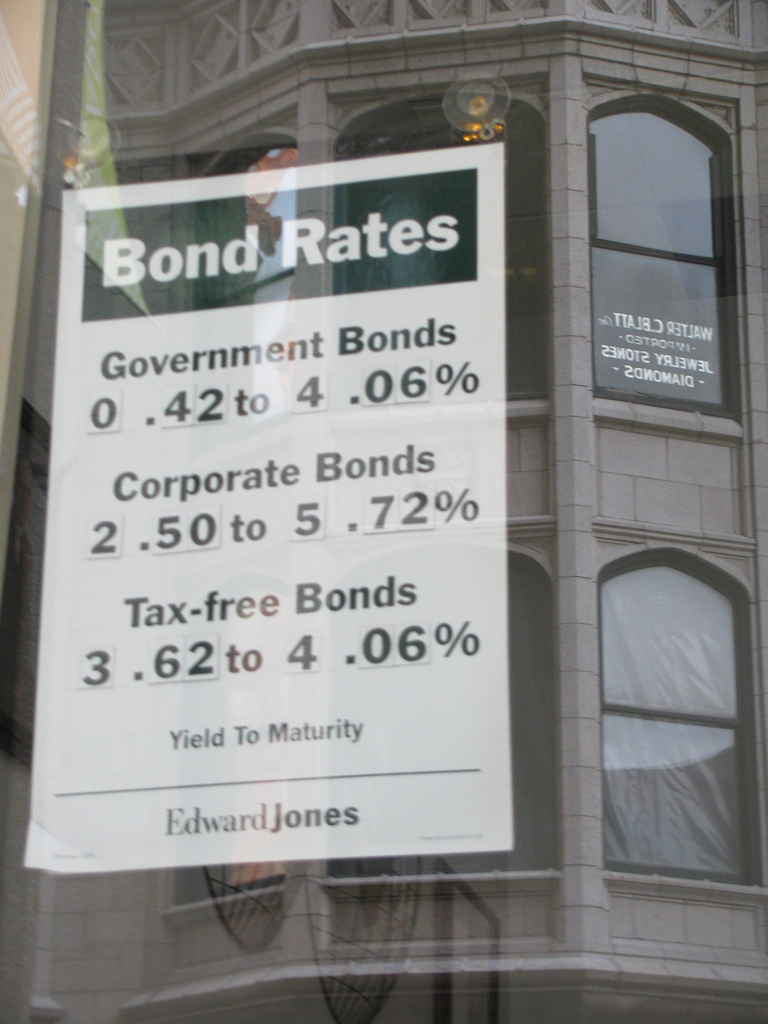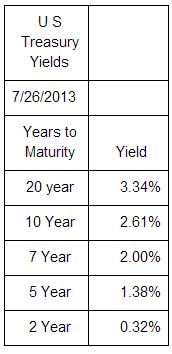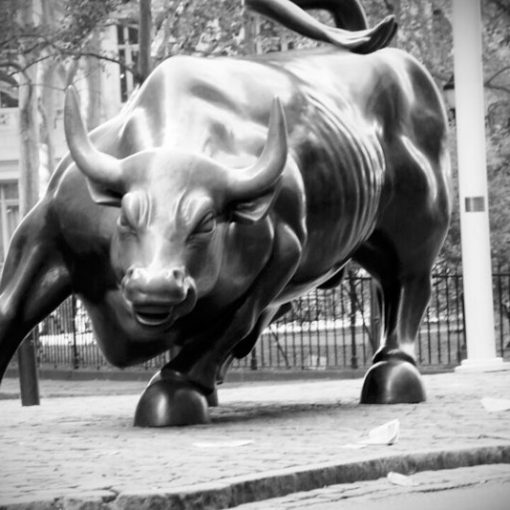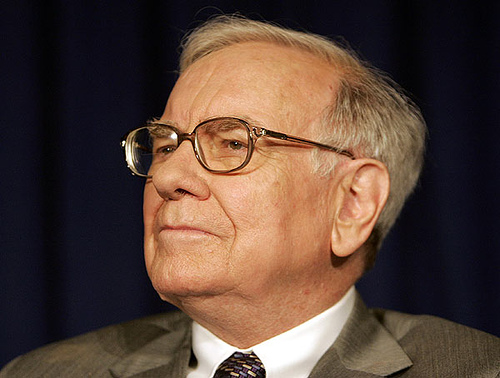Since the bond market had its little hissy fit over Ben Bernanke’s “tapering” comments a month or so ago we’ve heard a great deal about an upcoming bear market in bonds. In GMO’s recent quarterly letter, James Montier goes so far to pose the question: “Are we witnessing the death of bonds as an asset class?’
The premise of Montier’s comments is that if interest rates stay flat, we’ll be stuck in a low yielding investment environment. And if interest rates rise, then even worse – you are stuck in a depreciating asset, as bonds go down in value as interest rates rise. But this is only a half truth.
True, if we have an interest rate shock, as we did in May and June of this year when yields on the 10 year Treasury rose by 50%, an investor may see a relatively substantial drop in the value of their bond holdings. And for investors that are leveraged, or make their living selling short term performance, this is problematic.
However, this is where a knowledgeable and moderately patient investor has the potential advantage. While equity focused advisors tout short-term performance, income oriented managers focus on performance over the lifetime of the investment.
As an individual investor, be leery of equity oriented advisors who give advice on bond buying. Bonds require an analytical focus beyond short term performance numbers.
Before we look at the explanation, one caveat. What I am about to explain applies to a holder of a individual bonds – not a bond fund. As most market observers see a continued rise in rates somewhere in the near to intermediate future, bond funds can, and likely will, face permanent losses of capital. (An excellent discussion on this can be found on Advisor Perspectives.)
Where I take exception with most analysis, including those referenced above, is with the claim that a bondholder will be stuck receiving relatively low interest payments if rates rise, until their bond matures. At that time they receive the bond’s face value – presumably what they paid for the bond initially.
This assumption ignores the fact that a bond’s value actually increases over time as the bond approaches maturity. This is because in most, but not all cases, an investor accepts a lower interest rate on shorter duration bonds. This is shown in Chart 1 below:
Chart 1. U S Treasury Yields
Graphically therefore we have the “yield curve”:
Below in Chart 2, I’ve projected pricing on a recent quote I received for a bond maturing in 11 years. Assuming the purchase price to be at “par” (equal to the redemption value of $1000), a coupon or interest rate of 3.75%, and a straight-line yield curve, Chart 2 projects the value of the bond as it approaches maturity.
History has shown us yield curves that slope steeply, are flat, and even inverted (when short-term rates are higher than long-term rates). So while a straight-line yield curve is unlikely, there is no “normal” that would provide a more accurate projection.
Chart 2. Annual Re-pricing of an 11 Year Bond
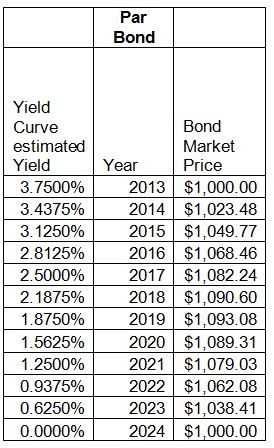
Graphically:
Assuming an upward sloping yield curve, you can see from the above chart and graph that a bond’s price is not constant. Since the coupon is constant, the bond becomes more valuable as it approaches maturity.
In other words, the 3.75% interest payment from the bond, while appropriate at the time of issue for the stated maturity, is actually a higher interest rate than the market would deliver as the bond goes from an 11 year bond to a 10 year bond, to a nine year bond, etc.
At some point, in this case about half way to maturity, the bond’s price will begin to depreciate toward its maturity value. This is because a buyer of our original 11 year bond in year six will pay a premium price because he is receiving $37.50 in annual interest payments.
Looking back at Chart 2, the expected yield on a six year bond is only 1.875% or $18.75 per year. However, in life or at least on Wall St. there is no free lunch. So the buyer of our bond after year six will take a loss at maturity if paying a premium. As the bond moves closer to maturity the buyer has less time to recoup the premium in the price paid so the price declines.
Since the current perception is that interest rates will rise, let’s look at the same scenario above, but assume that we see a 50% rise in interest rates after our initial purchase. This would not be unlike the scenario facing the purchaser of a similar bond on May first of this year.
Chart 3. Effects of an Interest Rate Increase

In this case, our bondholder has in fact been hit with a loss on his/her bond initially. But again, this is assuming a very large interest rate increase within the first year of purchase. However, looking at the table above, in 2019 with five years remaining to maturity, we would expect to buy a 5 year bond with a 3.75% interest rate. So the value of our bond has returned to par in just seven years.
Summary: Our bond buyer buys a bond originally paying 3.75% and expects to hold it for 11 years when it is redeemed at face value. Interest rates unexpectedly rise by 50% along all maturities. If our bond buyer had waited until after rates had risen he could have bought the same bond with a yield of 5.625% for the same 11 year period.
This is where most analysis ends, making it look like buying a bond when rates are rising as a bad deal. But the reality is our bond will likely rise back to par value well before maturity, in this example, 7 years. If our investor sells at that time he will get his 3.75% interest, but from what effectively became a seven year bond instead of the original eleven – which is exactly what the market rate has become after the 50% rise in rates.
Investment Lessons: Too many investors, advisors, and pundits assume bonds are a buy and hold until maturity investment. As a result, they look at the short term impact of rising rates as a reason to avoid the entire asset class. And the short term loss isn’t worth the safety and diversification afforded by waiting for redemption at maturity.
Bond managers, by comparison, look at total return over the life of an investment, not quarter by quarter performance. As a result the buy and sell decision is actively managed by looking at pricing relative to the shape of the yield curve and likely direction of interest rates.
In a flat interest rate environment, intermediate term bonds can provide capital appreciation opportunities., and still add capital protection and market interest rates in a rising rates scenario. For investors looking for safety, diversification, and income, individual bonds are still very attractive in the current environment.
Photo Credit: Digital Sextant
All opinions included in this material are as of July 30, 2013 and are subject to change. The opinions and views expressed herein are of the portfolio manager and may differ from other managers, or the firm as a whole. All investments involve risk (the amount of which may vary significantly) and investment recommendations will not always be profitable. Past performance does not guarantee future results.
